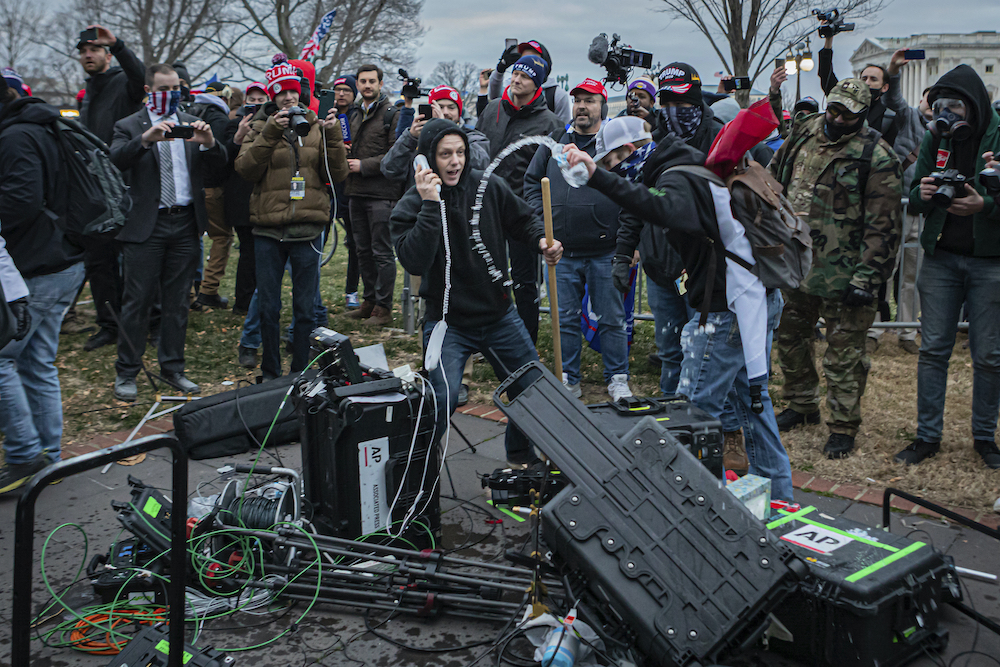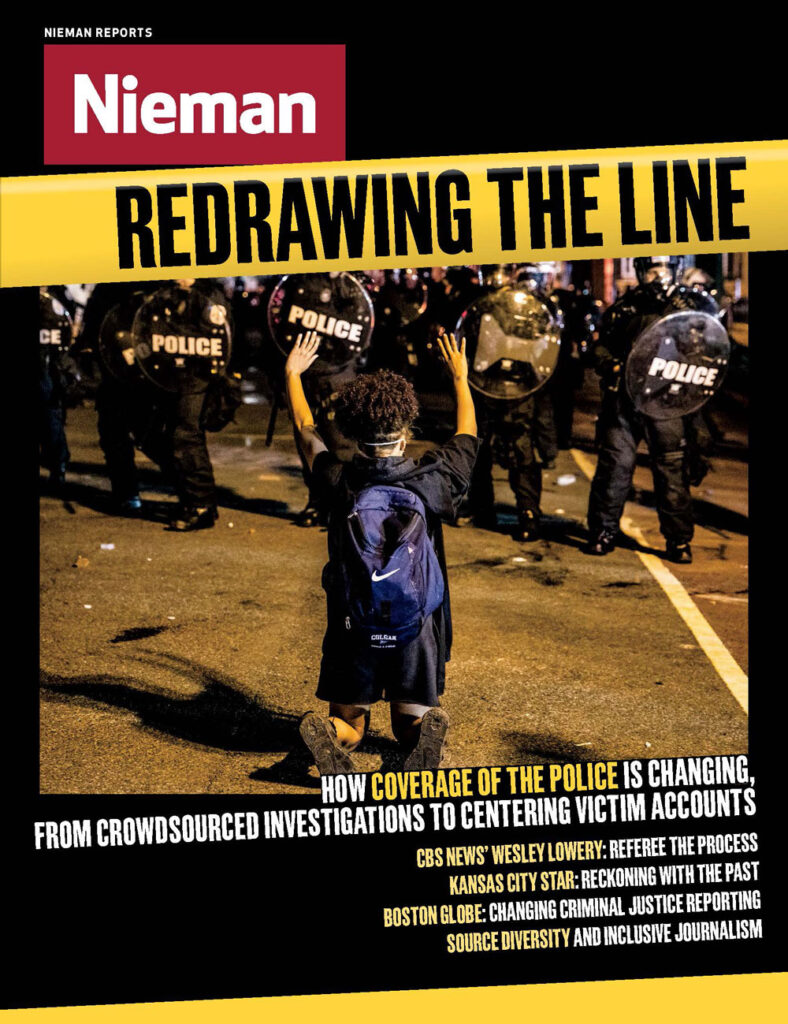January 6, 2021, wasn’t one of those days.
As violent pro-Donald Trump rioters laid siege to the U.S. Capitol, disrupting congressional certification of the 2020 election results, an image circulated of a grim message scrawled on a door to the hallowed building: “Murder the Media.” Gillespie, a survivor of the 2018 disgruntled-reader rampage in Annapolis, Maryland, that left five Capital Gazette newsroom colleagues dead, had to respond — and began tweeting out his portraits of the fallen and their survivors.
“That might just be words [to] whoever wrote that, or they might think it’s funny, or they might really mean it — but it happened to me ... Five of my Capital Gazette family members were murdered all around me. My head was almost taken off my body,” he says. “[I] had to let it be known: [We’re] not make-believe. We are real people who live in your communities, and we go to the job every day just trying to do the best job we can.”
As Gillespie notes, the motive for the notorious Annapolis shooting, unlike the January 6 rampage, did not center on outgoing President Trump, who systematically stoked suspicion and hatred of the press even before his 2016 election. As the inauguration of President-elect Joe Biden approaches, Gillespie and others in the field remain concerned about a political climate that has been fertile ground for attacks, rhetorical and physical, on the media Trump demonizes.
There’s been a torrent of condemnations of the violence at the Capitol, where reporters and photographers tell of being threatened with shooting and working among demonstrators wearing T-shirts with slogans like “Hang the media.” New York Times photographer Erin Schaff described being thrown to the ground by hostile men in black as the Capitol was overrun. Julio Cortez of The Associated Press shared video of his colleague, photographer John Minchillo, being bodily dragged into a crowd of Trump supporters. “This is a reminder of the dangers journalists both in the U.S. and around the world face every day while simply trying to do their jobs,” says AP spokesman Patrick Maks.
More than 2,000 miles away, photojournalist Rick Egan of the Salt Lake Tribune was covering a pro-Trump demonstration at the Utah State Capitol on Jan. 6 when a man rushed him and pepper-sprayed him in the face. A colleague flushed Egan’s eyes with water after the assault, which the paper decried as an unacceptable attack on local journalism. Once his eyesight returned, Egan says, he stayed and made photos for another two hours.
Egan, a 36-year veteran of the Tribune, thinks Trump bears responsibility for stoking anti-media animus: “Making us ‘the enemy of the people’ has made it hard … In the Tea Party days, they didn’t really like us either, [but] they didn't treat us like the Trump people do, or the anti-mask people do, or the militia people … They just come right at us, like, ‘Who are you with?’ and ‘What do you think you're doing here?,’ Egan says. “[They] attack us, which is something totally new to me in my career.”
While some people believed once Trump lost, “a lot of these people [would] peel off and think, ‘Okay, he really is a loser [and] half the stuff he says are lies,’ [that] hasn’t seemed to happen yet,” Egan adds. Even if the violent group “is a small fringe [when] compared to the [whole] population, it's big enough to crash through the doors of the Capitol.”
The rage Trump normalized in the past five years is in some ways elemental. Bernard Golden, a Chicago-based psychologist and author of “Overcoming Destructive Anger: Solutions That Work,” says “Anger is energizing; it’s like a shot of caffeine in our body. We feel more alive with anger.” While in decades past, people viewed an “angry” politician as flawed, he says, widespread “modeling of anger gives us permission to be angry” — whether it's from the very top of the government or a proliferation of TV news and talk shows that have found that conflict sells.
“Those people who marched into the Capitol, they felt empowered,” Golden says. “Anger could become an identity, and it [has].”
Trump’s messaging has clearly had its deleterious effect on public discourse — both by defining it and by derailing it. During recent Senate runoffs in Georgia, Golden says, candidates tried to debate concrete issues like the economic stimulus and health insurance, but “Trump and others like him have completely distracted them by the hatred, finding ‘the other’ to focus on, rather than [the] hard task of coming up with answers to the problems we have.”
Diminishing the media is something Trump became incredibly good at — but it’s obviously not a new tactic. “The statement that the media is ‘the enemy of the people’ is straight out of Stalin’s playbook, but more recently, [look] at what happened in the Balkans during the ’90s, [and what’s] happening in the Philippines. It is a global phenomenon,” says Tanya Domi, an adjunct professor of international and public affairs at Columbia University and an expert on the Balkans and autocratic leaders in Eastern Europe.
The Fairness Doctrine, which requires FCC-licensed TV and radio stations to give airtime to controversial public issues and allow opposing viewpoints on them, “needs to be re-instituted across all new contemporary platforms in which media is reported, [and] that has to become a priority,” along with stronger education in areas like civics, says Domi. She also encourages congressional hearings, pushed by the heads of media organizations, on threats to a free press: “Journalists [are] harassed and have been threatened around the world and [they] live with it in a way that [is] really honorable, but after a while, that really diminishes your capacity to stay at it without backing of the editorial leadership. What you learn about autocrats is that they’ll threaten and belittle and intimidate as long as they have the room to do it.”
Thanks to the catastrophe in Washington, Trump’s ability to suck up oxygen and directly mobilize his followers has suffered a body blow: With days left in his presidency, and facing possible impeachment or invocation of the 25th Amendment, he saw major social media platforms kill his mic. Twitter, his prime megaphone, permanently suspended his account on January 8 “due to the risk of further incitement of violence.”
Tim Riley, an associate journalism professor and graduate program director at Emerson College, thinks that will help lower the temperature — but only until he and his followers find ways to reconnect.
Riley says even the most basic measures should help outlets cover the denouement of Trump’s tenure well but without needlessly inflaming tensions: Emphasizing the truth, not the falsehood, when debunking lies; renewed resistance to anonymous sourcing; and a stronger vetting of broadcast guests that prioritizes integrity over party affiliation or administration ties. Not everyone may agree with all of it, he says, but in the defense of democracy, “it’s far more useful to clash swords over the coverage than trying to defend [a] weak, aimless, ‘view from nowhere,’ ‘both-sides-matter’ approach. Both sides simply don’t matter as much; that's part of our burden as journalists. We should not get sheepish about defending our choices."
On the ground in D.C. and at statehouses across the country that had satellite pro-Trump rallies on January 6, coverage and safety choices had to be made by reporters in real time.
A video clip widely circulated during the Capitol rioting shows Andrew Wafford, a photojournalist for WJLA, a Washington, D.C. ABC affiliate, getting swarmed by Trump supporters shouting “Fake news” and “Get the f— out of here.” Unlike Egan, who was ambushed in Utah, Wafford had the opportunity to extricate himself from the situation — and calmly did.
“I’m not one to run or to scurry away from a situation, no matter how dangerous it is, [but] I walked away. I didn’t think [it] would have been the wisest thing to say anything or just to confront them — as much as I wanted to,” says Wafford, who’s been with the station less than a year. He shared the video because “I want people to understand what [we] deal with in these types of situations.”
Staying cool may not always be easy: Having “Murder the media” messages out there “made me even more grateful that [my] situation didn’t turn bad,” Wafford says in retrospect. “What if the person that was behind me was the one who wrote ‘Murder the media’? ... I literally saw someone walk past me with a pitchfork. A pitchfork. [I] saw people with sticks and objects to hit people with and throw at people.”
While Wafford walked away from the vitriol with his gear intact, others weren’t as lucky.
D.C.-based Ford Fischer, whose activism footage is used by news outlets and documentarians via his company, News 2 Share, was at the Capitol when a mob overran a camera position, driving out the press on duty and destroying their equipment. He remembers a reporter’s “real scream of fear.” The marauders "picked things up and then smashed them back on the sidewalk, and they were chanting, ‘Fake news! Fake news! We’re the media now,’ and that moment, for me, was horrifying,” Fischer says.
While covering groups like the extremist Proud Boys, Fischer says he’s seen that even in confrontational, anti-media situations, the hardcore right will “listen to leaders, [and to] hierarchical, top-down commands.” That leads him to believe “the thing that would probably cause Trump’s supporters to not have this level of animosity toward the media would be if they heard it out of President Trump’s mouth.”
The odds of that happening?
“Extremely minuscule.”




